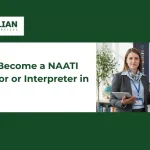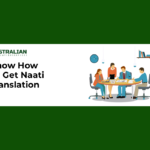Live your dream of working in Australia with the right work visa!
Australian working holiday visa, permanent work visas, and multiple work visa options Australia let you stay in Australia, submit your application, and easily start your journey toward work in Australia permanently. The visa process includes step-by-step guidance for different visa types, from specified work to study in Australia or travel to and from Australia.
Each visa requires you to meet eligibility requirements and allows you to work in fields that fit your goals; whether you want specific work, study, or travel, there’s a visa that lets you stay longer and work in Australia permanently. Follow this guide to discover which Australian Work Visa allows you to work, what visa requires for approval, and the application process for every type of work that helps you get approved fast, so you can submit your application and start your new Australian adventure.
What Is an Australian Work Visa?
An Australian Work Visa is an official permit issued by the Australian government that allows foreign nationals to work legally in Australia for a specific period, or permanently, depending on the visa type.
These visas are designed to support Australia’s economic and skill needs by welcoming skilled professionals, recent graduates, temporary workers, and sponsored employees into the workforce.
What Are the Different Types of Australian Work Visas Available?
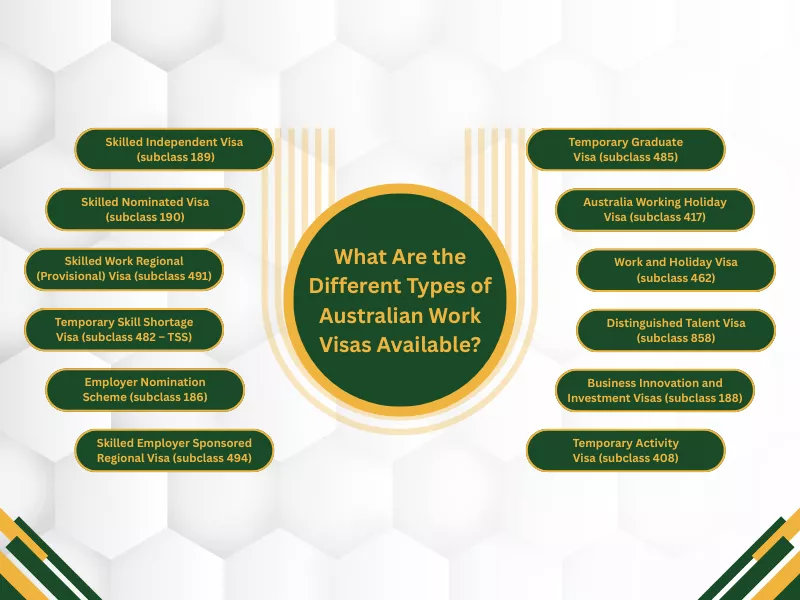
Australia offers a wide range of work visas for those who want to live and work in Australia, each catering to specific requirements, work experience in your field, and pathways to become an Australian citizen. The main work visas in Australia include employer-sponsored, skilled, regional, holiday, and activity visas with various streams for this visa, whether you want to stay in Australia temporarily or work in Australia as permanent.
Skilled Independent Visa (subclass 189)
Points-tested for skilled workers not sponsored by an employer, family, or state/territory. For example, engineers need a Competency Demonstration Report to meet the eligibility requirements. This skilled regional visa lets you apply for this visa and become an Australian citizen after some years. Work visas require meeting stringent requirements and application steps.
Expert Insight: The Subclass 189 is often considered the ‘gold standard’ of Australian visas because it grants permanent residency from day one without requiring a job offer. However, it is extremely competitive. A successful application to work in Australia as permanent resident typically requires a high points score (often 85+) and an occupation on the Skilled Occupation List. For many applicants, the state-nominated (190) or regional (491) visas offer a more attainable pathway to the same goal.
Skilled Nominated Visa (subclass 190)
Points-tested for skilled workers nominated by an Australian state or territory. You must pay the application fee and meet the strict requirements to live in Australia.
Skilled Work Regional (Provisional) Visa (subclass 491)
A points-tested visa for highly skilled individuals nominated by a state/territory or sponsored by an eligible family member to work in regional Australia. It is valid for five years and provides a pathway to permanent residency after three years.
Temporary Skill Shortage Visa (subclass 482 – TSS)
Allows employers to sponsor a skilled worker to fill a position they cannot find a suitable Australian to fill. It includes Short-Term, Medium-Term, and Labour Agreement streams and is typically valid for up to four years, with a potential pathway to permanent residency.
Employer Nomination Scheme (subclass 186)
For skilled workers nominated by an Australian employer. It has three streams: Direct Entry, Labour Agreement, and Temporary Residence Transition.
Skilled Employer Sponsored Regional Visa (subclass 494)
A temporary work visa Australia valid for five years for skilled workers nominated by an employer in a designated regional area. Holders may apply for permanent residency after three years.
Temporary Graduate Visa (subclass 485)
This post-vocational education work stream program allows international students who have recently graduated from an Australian institution to stay, work, or study temporarily. It has two streams (Post-Vocational Education Work and Post-Higher Education Work) and is valid for a period ranging from 18 months to four years.
Australia Working Holiday Visa (subclass 417 Visa)
For passport holders from eligible countries (e.g., UK, Canada, Ireland, France, Italy). The age limit is 18-30, but for some nationalities, including British citizens, it is extended to 35. This visa has no specific educational requirements.
Work and Holiday Visa (subclass 462 Visa)
For passport holders from a different set of eligible countries (e.g., USA, Argentina, China, Spain). The age limit is 18-30. This visa has educational and language requirements, and citizens of some countries need a letter of support from their government.
Distinguished Talent Visa (subclass 858)
A permanent visa for individuals with an internationally recognised record of exceptional achievement in a profession, sport, the arts, or academia and research.
Business Innovation and Investment Visas (subclass 188)
For skilled workers nominated by an employer in regional Australia. Applicants must have worked for the same employer on a previous valid visa.
Temporary Activity Visa (subclass 408 Visa)
For individuals to undertake specific short-term work, including participation in special government programs, religious work, research, sporting activities, or cultural events.
Temporary Work (International Relations) visa (subclass 403 visa)
For work in diplomatic, governmental, or other special programs.
Is It Hard to Get a Work Visa in Australia?
Choosing Your Visa
To decide which work visa suits you, think about your goals, eligibility, and work experience in your field. All visas have requirements you must meet, pay the application fee, and can let you study and work, travel to and from Australia, or live and work in regional areas, depending on the streams for this visa. Whether you’re looking for the months of specified work to apply for a second holiday visa, want to move to Australia temporarily, or become an Australian citizen after permanent work visas, review each specific visa to ensure you meet the eligibility requirements before applying.
How Long Can You Stay on Different Work Visas?
Temporary Skill Shortage (TSS) Visa – Subclass 482
| Stream | Duration | Extension | Path to PR |
| Short-Term Stream | Up to 2 years (or 4 if international trade obligation applies) | 1 renewal in most cases | ❌ Not usually eligible for permanent residency |
| Medium-Term Stream | Up to 4 years | Unlimited renewals | ✅ Eligible for PR via Subclass 186 or 187 |
| Labour Agreement Stream | Varies (typically 4 years) | Depends on agreement | ✅ May lead to PR |
Employer Nomination Scheme (ENS) – Subclass 186
| Stream | Stay Duration | Notes |
| Direct Entry Stream | Permanent | For applicants who meet skill and English language criteria |
| Temporary Residence Transition (TRT) Stream | Permanent | For TSS (482) holders after working 2–3 years with the employer |
| Labour Agreement Stream | Permanent | Based on agreements with specific employers/industries |
Skilled Employer Sponsored Regional (Provisional) Visa – Subclass 494
For employers in regional areas.
- Duration: Up to 5 years
- Path to PR: Yes, after 3 years via Subclass 191 (permanent regional visa)
- Must live and work in a designated regional area.
Temporary Graduate Visa – Subclass 485
| Stream | Duration |
| Graduate Work Stream | Up to 18 months (2 years for Hong Kong citizens) |
| Post-Study Work Stream | 2 to 4 years, depending on degree level |
| Second Post-Study Work Stream | 1–2 additional years (if studied in regional Australia) |
Does not require sponsorship. May lead to PR through other skilled visa programs.
Global Talent Visa – Subclass 858
- Stay: Permanent Residency
- For individuals with internationally recognised achievements in a target sector.
How to Apply for an Australian Work Visa: Step-by-Step Guide
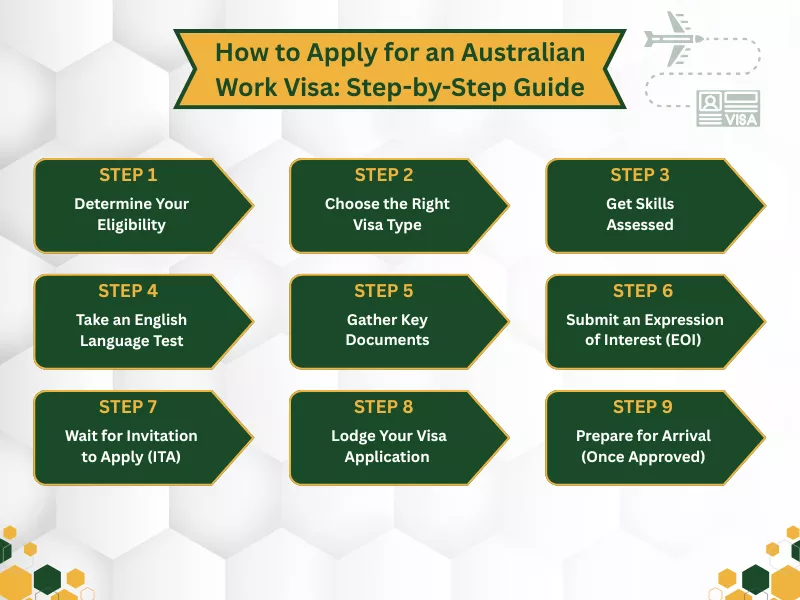
Step 1: Determine Your Eligibility
Before starting, make sure you meet the basic criteria:
- Your occupation is on Australia’s Skilled Occupation List (SOL)
- You have relevant qualifications and work experience
- You meet health, character, and age requirements
- You have a sponsoring employer (for employer-sponsored visas) or meet points threshold (for skilled visas)
Step 2: Choose the Right Visa Type
Select a visa that best matches your work situation:
| Visa Type | Description |
| TSS 482 | Employer-sponsored temporary visa (2–4 years) |
| Subclass 186 | Permanent residency via employer nomination |
| Subclass 189/190/491 | Skilled independent/state-nominated visas |
| Subclass 494 | Skilled regional (provisional) visa |
| Subclass 485 | Temporary visa for recent graduates |
| Subclass 858 | Global Talent (PR for top-tier professionals) |
Step 3: Get Skills Assessed
You must prove your skills match the Australian standards for your occupation.
- Assessment Authority: Varies by profession (e.g., Engineers Australia, VETASSESS, CPA Australia)
- Prepare detailed employment history, qualifications, and references
- This step is mandatory for most skilled and employer-nominated visas
Step 4: Take an English Language Test
Most applicants must prove their English proficiency via an approved test:
- Accepted Tests: IELTS, TOEFL iBT, PTE Academic, Cambridge C1
- Required score varies by visa (e.g., minimum IELTS 6.0 in each band for most skilled visas)
Step 5: Gather Key Documents
Start collecting all supporting documents early:
- Passport and ID
- Educational qualifications
- Employment references
- English test results
- Skills assessment result
- Police certificates (for character check)
- Health exam results (you’ll be told when to take one)
Important Note on Documents: Any document that is not in English must be submitted with a NAATI-certified translation. This is a strict government requirement, and using a professional, certified translation service is essential to prevent application delays or rejections.
Step 6: Submit an Expression of Interest (EOI)
(For points-tested visas like 189, 190, 491)
- Create an account in SkillSelect
- Submit your EOI with accurate details
- Include visa preferences, skills, experience, test scores
- EOIs are valid for 2 years — no cost to submit
Step 7: Wait for Invitation to Apply (ITA)
(For points-based visas only)
- If you meet the criteria and rank high enough, you’ll receive an Invitation to Apply from the Department of Home Affairs
- For state-sponsored visas, apply to the state or territory first
Step 8: Lodge Your Visa Application
Once invited (or if you’re applying directly like with Australia Work Visa TSS), submit your full application online via ImmiAccount:
- Upload all required documents
- Pay the visa application fee
- Wait for the decision (processing time varies by visa type)
Step 9: Prepare for Arrival (Once Approved)
Once your visa is approved:
- Book your travel
- Organise accommodation and health insurance
- Understand your visa conditions (work limitations, location restrictions, etc.)
- Register for a Tax File Number (TFN) and Medicare if eligible.
How Much Is a Working Visa in Australia?
Disclaimer: Fees are sourced from the Department of Home Affairs and are correct as of October 2025. Visa application charges are subject to change, so always confirm the current cost on the official government website before applying.
| Visa Type | Primary Applicant | Additional Adult (18+) | Child (Under 18) | PR Eligible? |
| TSS 482 – Short-Term | $1,455 | $1,455 | $365 | ❌ |
| TSS 482 – Medium-Term | $3,035 | $3,035 | $760 | ✅ |
| ENS 186 – Employer Nomination | $4,640 | $2,320 | $1,160 | ✅ |
| Skilled Independent 189 | $4,640 | $2,320 | $1,160 | ✅ |
| Skilled Nominated 190 / Regional 491 | $4,640 | $2,320 | $1,160 | ✅ |
| Temporary Graduate 485 | $1,895 | $950 | $475 | ❌ (PR possible later) |
| Global Talent 858 | $4,640 | $2,320 | $1,160 | ✅ |
Common Mistakes That Can Delay Your Australian Work Visa
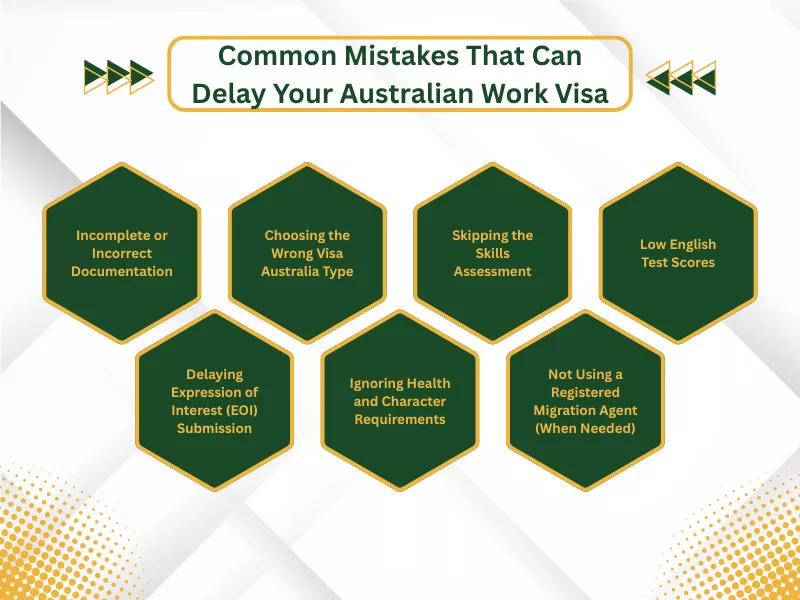
Applying for an Australian work visa can be a complex process, and even small errors can lead to delays or rejections. Here are the most common mistakes to avoid — whether you’re applying directly or using a Visa Document translation services in Australia to assist with your documents.
Incomplete or Incorrect Documentation
Missing documents, outdated forms, or inconsistencies in your application can cause significant delays.
➡ Tip: Double-check all required documents and ensure they’re properly translated by a certified translation service in Australia if not in English.
Choosing the Wrong Visa Australia Type
Many applicants select a visa that doesn’t match their job, location, or long-term goals (e.g., choosing a short-term visa when eligible for PR).
➡ Research thoroughly or consult a migration agent to match your needs with the right visa subclass.
Skipping the Skills Assessment
For most skilled visas, a positive skills assessment is mandatory. Skipping this step will lead to a visa refusal.
➡ Start this process early — it can take several weeks or months.
Low English Test Scores
Failing to meet the minimum English language requirements (e.g., IELTS or PTE scores) can halt your application.
➡ Practice beforehand and take a recognised English test. Retake it if necessary to meet the required score.
Delaying Expression of Interest (EOI) Submission
For visas like the 189, 190, or 491, an EOI in SkillSelect is the first step.
➡ Waiting too long to submit your EOI can delay your Invitation to Apply (ITA) — especially if competition is high in your occupation.
Ignoring Health and Character Requirements
Not completing health exams or police clearances in time can stall the process.
➡ Book your medical checks and gather police certificates early to avoid last-minute issues.
Not Using a Registered Migration Agent (When Needed)
While many applicants can apply on their own, complex cases (e.g. visa refusals, employer nomination issues) often benefit from expert help.
➡ Always use a registered migration agent — and if your documents are in another language, be sure to use a professional translation service in Australia to avoid errors or rejections.
Common Myths and Real Truth
When applying for an Australian work visa, a lot of misinformation can lead to confusion, costly mistakes, or missed opportunities. Let’s break down the most common myths and share the real truths — plus a key tip on the Documents Required To Be Translated To Apply For Student Visa Australia, which also applies to work visa applicants.

You Don’t Always Need a Job Offer to Get In
❌ False.
You don’t always need an employer to sponsor you.
✅ Truth: Visas like the Skilled Independent Visa (Subclass 189) or Skilled Nominated Visa (190) allow skilled workers to apply without a job offer, based on points, qualifications, and occupation demand.
➡ These visas can lead directly to permanent residency.
The “Working Holiday” Is More Powerful Than You Think
❌ False.
Many think the Working Holiday Visa (Subclass 417/462) is just for fun and travel.
✅ Truth: This visa can be a stepping stone into longer-term work visas or even permanent residency — especially if you work in regional areas or high-demand sectors.
➡ It’s more powerful than it seems — a great way to get a foot in the door.
“Temporary” Visas Can Be Your Path to “Permanent”
❌ False.
Some believe temporary work visas have no long-term benefit.
✅ Truth: Many “temporary” visas (like the TSS 482 or Graduate 485) can lead to permanent residency, especially if you meet employer nomination or regional work requirements.
➡ With the right planning, a temporary visa can be your path to PR.
The Visa Menu is Hyper-Specific
❌ False.
People often assume there’s just “one work visa” for Australia.
✅ Truth: The Australian visa system is highly specific — with over 20+ work-related subclasses tailored by skill level, occupation, location, and visa purpose (e.g., regional vs metro).
➡ Choosing the wrong one can delay or destroy your chances.
The Price Tag is More Complicated Than You Think
❌ False.
Many applicants focus only on the base visa application fee.
✅ Truth: You may also need to pay for:
- English language tests
- Skills assessments
- Medical exams
- Police certificates
Professional document translations (use a certified translation service in Australia for non-English documents)
➡ The total cost can easily exceed $5,000+, depending on your situation.
Frequently Asked Questions
How Do I Get a Work Visa for Australia?
You must meet skill, health, and character requirements, choose the right visa type, gather documents, and apply online via ImmiAccount or after receiving a nomination.
What Is the Difference between a 457 and a 482 Visa?
The 457 visa is discontinued. The 482 visa replaced it, offering short- and medium-term streams for skilled workers sponsored by approved Australian employers.
Is It Safe Living and Working in Australia as a Foreigner?
Yes, Australia is generally very safe. It offers strong worker rights, a multicultural society, and high-quality healthcare and education for foreign workers and their families.
Can I Apply for a Work Visa without a Job Offer in Australia?
Yes, for certain skilled visas like Subclass 189 or 190. These are points-based and don’t require employer sponsorship, but you must meet occupation and assessment criteria.
- Language Disorder or Language Difference: How to Know? - November 29, 2025
- AI Localization and Automation: Best Practices for Translation - November 13, 2025
- Australian Work Visa: Get Approved Fast with This Step-by-Step Guide! - October 28, 2025


